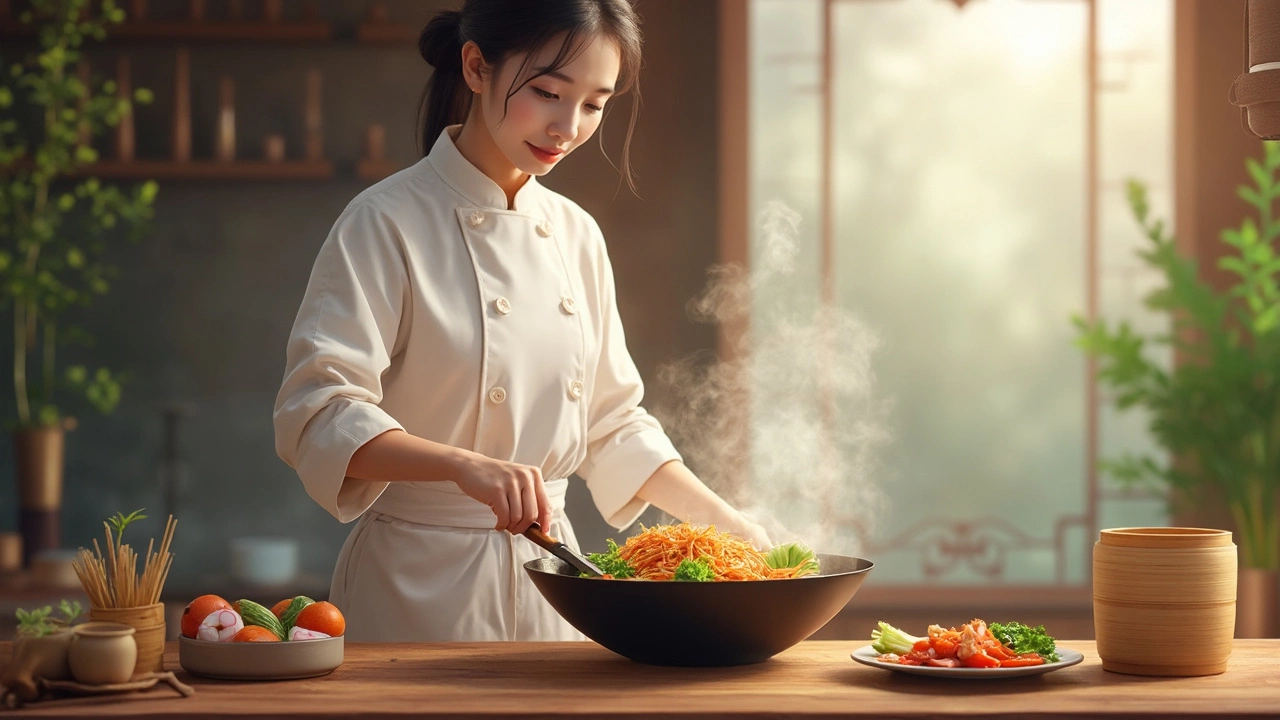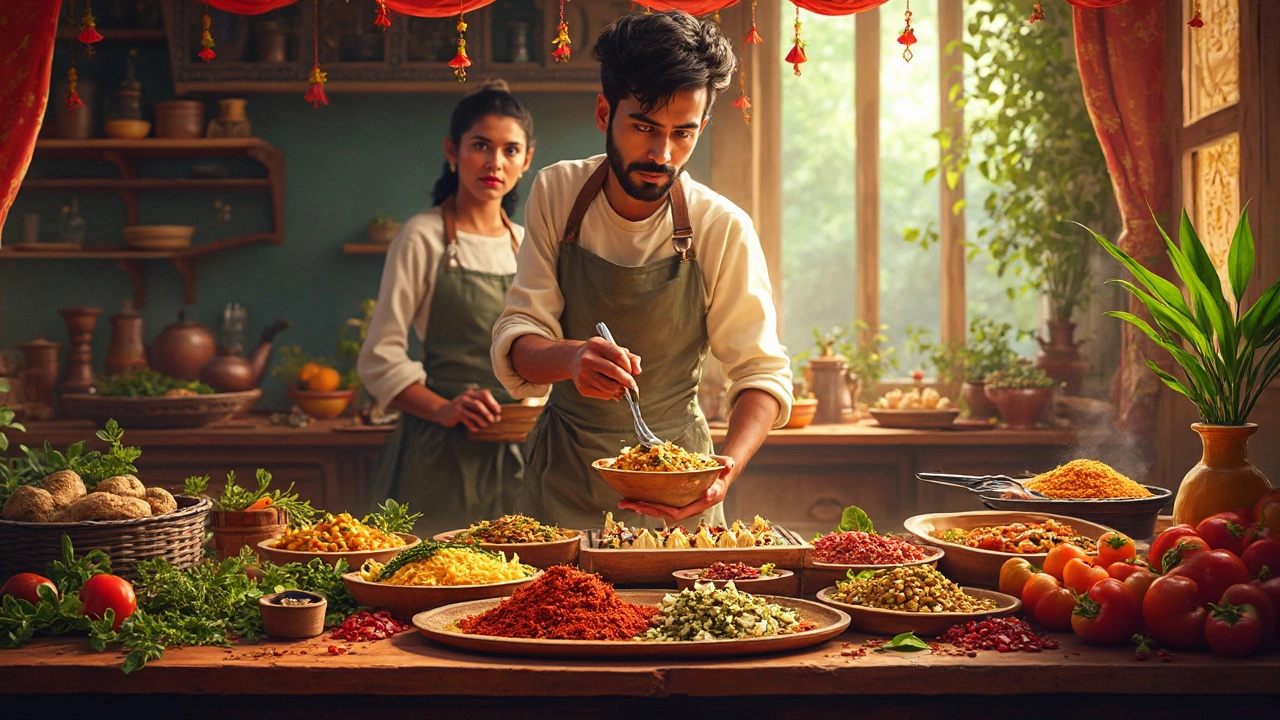So, ever found yourself torn between ordering Indian dal or Chinese stir-fry? Both cuisines have their own charm, but how do they stack up health-wise? Let's dive into the flavors and ingredients, because these two culinary giants are more than just takeout favorites.
Indian food is famous for its spices—turmeric, cumin, coriander, to name a few. These not only add flavor but bring health benefits. Turmeric, for example, is known for its anti-inflammatory properties. Indian dishes usually have a lot of veggies and lentils, making them a fiber-rich option.
On the flip side, Chinese cuisine isn't just about noodles and fried rice. Traditionally, it's about balance. Stir-frying keeps veggies crisp and fresh, preserving their nutrients. Plus, Chinese dishes usually have a good mix of protein and veggies. But, watch out for MSG and the amount of oil used, as those can sneak unhealthy elements into your meal.
- The Nutritional Power of Indian Cuisine
- Exploring Chinese Culinary Traditions
- Health Myths and Facts
- Easy Indian Recipes to Try
The Nutritional Power of Indian Cuisine
Ever wondered why your grandma insists on adding turmeric to just about everything? Well, she might be onto something. Indian cuisine is a treasure trove of nutrition thanks to its diverse ingredients and cooking methods. From lentils to spices, there's a lot going on health-wise that can benefit anyone looking to switch their diet up.
Let's look at turmeric first—this vibrant yellow spice isn't just for color. It's loaded with curcumin, an active ingredient that fights inflammation and has antioxidant properties. Pretty cool for a spice, huh? And it's not just turmeric; Indian dishes often feature spices like cumin and coriander, which can aid digestion.
When it comes to the base of many dishes, we can't ignore the role of lentils and legumes like chickpeas. They're brimming with protein, iron, and fiber. This makes them a solid option for vegetarians and anyone wanting to cut down on red meat. Plus, they're super filling!
The veggies in Indian food aren't just garnishes. A lot of meals are loaded with fresh produce, automatically boosting your vitamin intake. Whether it's spinach in palak paneer or potatoes in aloo gobi, there's no skimping on the greens.
One thing to keep in mind is the use of ghee (clarified butter) and oil. While ghee is rich in fat-soluble vitamins like A, D, E, and K, it should be used in moderation. Overdoing any high-fat ingredient can take a meal from healthy to heavy real quick.
To sum up, if you're into experimenting with Indian recipes, you're not just exploring flavors but also boosting your intake of vitamins and minerals. Just remember to balance it out to keep things on the healthier side.
Exploring Chinese Culinary Traditions
There’s more to Chinese cuisine than just your regular takeout fare. Chinese food has a rich history that spans over thousands of years, deeply entangled with China’s vast and diverse culture. Let's break down some key aspects that make Chinese cuisine unique and potentially healthy.
First off, cooking techniques in Chinese cuisine are all about keeping it quick and nutrient-friendly. Stir-frying, steaming, and boiling are favs in every Chinese kitchen. These methods are not only fast but help maintain the food’s nutritional punch. For instance, steaming veggies means they retain more vitamins compared to boiling.
Ever heard of the balance yin and yang? It’s a big deal in Chinese cooking! It’s not just a flashy concept but a guideline to balance ingredients. Cold foods (yin) like cucumber balance hot foods (yang) like ginger and chili. This balance does more than just satisfy taste buds—it's believed to keep your body in check too.
Variety is another key player. A classic plate of Chinese food is often a rainbow of colors—each color indicating different nutrients. Cooking up a dish with red bell peppers, broccoli, carrots, and mushrooms, means you're hitting several nutrient categories all at once.
Let’s not forget, the Chinese love for tea which often accompanies meals. Green tea is a staple, serving up antioxidants with every sip. It's believed to aid digestion and speed up metabolism.
However, be cautious with sauces like soy and oyster, which can sneak in extra sodium. It’s all about moderation and making smart choices.
To give you a clearer snapshot of how these elements come together in a typical Chinese diet:
| Nutrient Aspect | Traditional Dish | Health Benefit |
|---|---|---|
| High Protein | Soy-based Tofu Dishes | Supports muscle growth |
| Rich in Vegetables | Bok Choy Stir-fry | Boosts fiber intake |
| Low Fat | Steamed Fish | Heart-friendly |
In conclusion, traditional Chinese culinary traditions focus on balance, variety, and maintaining wellness. It's about mixing the tasty with the nutritious, which can turn any meal into a healthy feast if done right!

Health Myths and Facts
When it comes to Indian recipes and Chinese food, myths about health are pretty common. There's a lot of chatter that Indian cuisine is just heavy curries and greasy naan, while Chinese is all about fried delights and MSG. But let's sort the fact from fiction.
First off, not every Indian dish is swimming in ghee. Sure, there's indulgence, but many traditional Indian dishes rely on roasting or steaming, using spices like turmeric and cumin instead of heavy oils for flavor. Lentils and beans are often the stars, providing tons of protein and fiber.
On the Chinese side, the stereotype of MSG in everything? That's not entirely true. MSG is mainly an American Chinese restaurant thing, and traditional recipes focus on fresh ingredients, quick cooking methods like stir-frying, and boiling to retain nutrients.
Let's break it down with some facts:
- Sodium Levels: Yes, soy sauce in Chinese cuisine can bump up sodium levels, but it's often used sparingly. Opting for low-sodium versions makes a big difference.
- Spices and Health: Indian spices like turmeric have well-documented anti-inflammatory properties, while ginger and garlic, common in both cuisines, are great for digestion and immune support.
- Calorie Count: The idea that all Indian foods are calorie-heavy just isn't right. Many dishes, like tandoori chicken, are grilled and pack fewer calories with lots of flavors.
Many believe Chinese food is packed with calories because of fried rice and noodles, but steamed choices like dumplings and veggies can be pretty healthy.
Both Indian and Chinese cuisines can be as healthy or unhealthy as you make them. It's all about the choices and tweaks you incorporate.
Easy Indian Recipes to Try
Craving some homemade Indian recipes but feeling a bit overwhelmed? No worries! Here are a few easy and healthy dishes that you can whip up without breaking a sweat. They're perfect if you love big flavors but want to keep things simple and healthy.
First up, let's talk about dal tadka. It's an Indian staple, rich in protein and really comforting. To make it, all you need are some lentils, turmeric, cumin, and a few other spices. After boiling the lentils, you temper them with the spices for that authentic flavor.
- Rinse a cup of lentils and boil with turmeric and salt.
- In a pan, heat a little oil or ghee, add cumin seeds, garlic, and chopped onions.
- Add tomatoes and let it cook until soft. Mix this with the cooked lentils.
- Top with some fresh coriander leaves before serving.
Next, let's make some aloo gobi, a classic potato and cauliflower dish. It's great as a main or a side and is super easy to make.
- Cut potatoes and cauliflower into bite-sized pieces.
- In a pan, heat oil and add a pinch of asafoetida (hing), mustard seeds, and cumin seeds.
- Add the veggies along with turmeric, red chili powder, coriander powder, and salt.
- Cover and cook until tender, stirring occasionally. Garnish with coriander leaves.
Looking for a non-veg option? Try chicken tikka. It's a crowd-pleaser and can be made healthy by baking or grilling instead of frying.
- Marinate chicken pieces in yogurt, lemon juice, and spices like garam masala, coriander powder, and cumin powder, for at least an hour.
- Thread them on skewers and grill or bake until cooked through.
- Serve with mint chutney for an extra kick.
These dishes are not just delicious but are packed with nutrients. Plus, they're easily customizable, so feel free to add your twist or adjust the spices to your taste. Cooking Indian recipes at home has its perks: you control the ingredients, keeping it healthy and just the way you like it!
